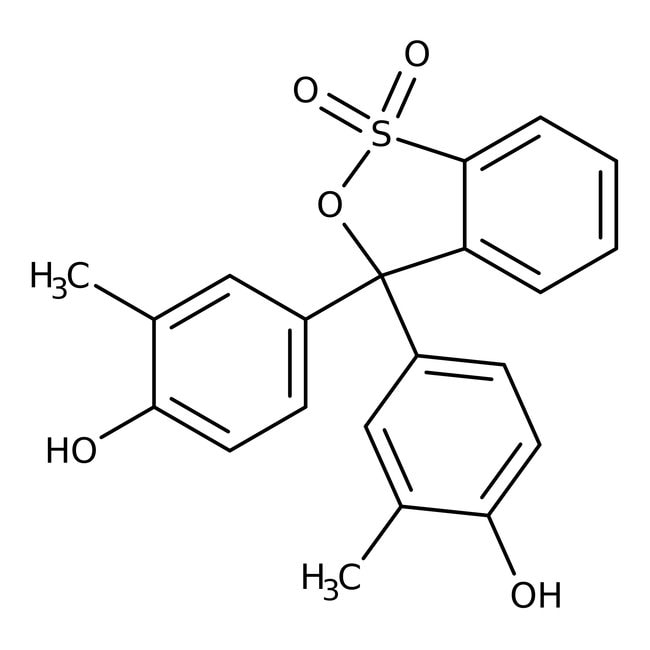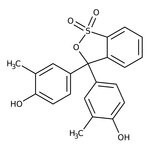Search Thermo Fisher Scientific
Thermo Scientific Chemicals
Cresol Red
Catalog number: A17243.22
100 g, Each



Thermo Scientific Chemicals
Cresol Red
Catalog number: A17243.22
100 g, Each
Quantity
Catalog number: A17243.22
also known as A17243-22
Price (USD)
Special offer:
162.65 191.00 Save 28.35 (14%)
Ends: 15-Oct-2024
Each
Quantity
-
Have Questions?
Chemical Identifiers
CAS
1733-12-6
IUPAC Name
3,3-bis(4-hydroxy-3-methylphenyl)-3H-2,1λ⁶-benzoxathiole-1,1-dione
Molecular Formula
C21H18O5S
InChI Key
OBRMNDMBJQTZHV-UHFFFAOYSA-N
SMILES
CC1=CC(=CC=C1O)C1(OS(=O)(=O)C2=CC=CC=C12)C1=CC=C(O)C(C)=C1
Specifications
Appearance (Color)
Dark green or red-brown or dark brown
Form
Powder
Color Change
pH 0.2-1.8: orange to yellow
Color Change
pH 7.0-8.8: yellow to red/purple
Loss on Drying
≤3% (105°C, constant weight)
Description
Cresol red is commonly used with lead acetate for the detection of urease after PAGE. It is also used as an indicator with the following transition intervals: pH 1.8 (orange) to pH 2.0 (yellow); pH 7.0 (yellow) to pH 8.8 (violet). Cresol Red is used as a tracking dye in DNA, RNA (agarose) and protein (polyacrylamide) electrophoresis. In agarose, Cresol Red runs with an apparent molecular size of approx. 125 bp DNA. Cresol Red does not inhibit Taq polymerase.
This Thermo Scientific Chemicals brand product was originally part of the Alfa Aesar product portfolio. Some documentation and label information may refer to the legacy brand. The original Alfa Aesar product / item code or SKU reference has not changed as a part of the brand transition to Thermo Scientific Chemicals.
Applications
Cresol red is commonly used with lead acetate for the detection of urease after PAGE. It is also used as an indicator with the following transition intervals: pH 1.8 (orange) to pH 2.0 (yellow); pH 7.0 (yellow) to pH 8.8 (violet). Cresol Red is used as a tracking dye in DNA, RNA (agarose) and protein (polyacrylamide) electrophoresis. In agarose, Cresol Red runs with an apparent molecular size of approx. 125 bp DNA. Cresol Red does not inhibit Taq polymerase.
Solubility
Soluble in water (slightly at 20°C), 50% ethanol (0.1%), dil. acids, and dil. alkalis. Insoluble in benzene.
Notes
Transition interval (acid): pH 1.8 (orange) to pH 2.0 (yellow); (alkaline) pH 7.0 (yellow) to pH 8.8 (violet)
Cresol red is commonly used with lead acetate for the detection of urease after PAGE. It is also used as an indicator with the following transition intervals: pH 1.8 (orange) to pH 2.0 (yellow); pH 7.0 (yellow) to pH 8.8 (violet). Cresol Red is used as a tracking dye in DNA, RNA (agarose) and protein (polyacrylamide) electrophoresis. In agarose, Cresol Red runs with an apparent molecular size of approx. 125 bp DNA. Cresol Red does not inhibit Taq polymerase.
Solubility
Soluble in water (slightly at 20°C), 50% ethanol (0.1%), dil. acids, and dil. alkalis. Insoluble in benzene.
Notes
Transition interval (acid): pH 1.8 (orange) to pH 2.0 (yellow); (alkaline) pH 7.0 (yellow) to pH 8.8 (violet)
RUO – Research Use Only
Figures
Documents & Downloads
Certificates
Search by lot number or partial lot number
Frequently asked questions (FAQs)
Citations & References
Search citations by name, author, journal title or abstract text